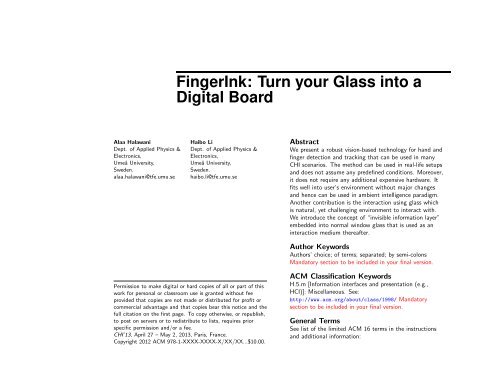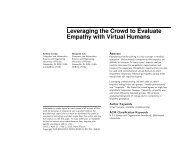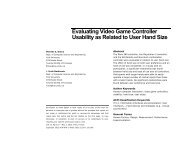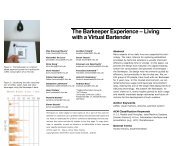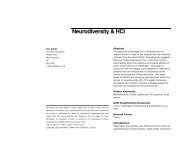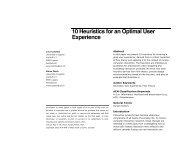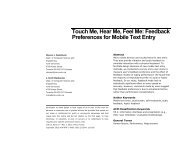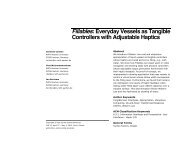SIGCHI LaTeX Extended Abstracts Template - alt.chi 2013
SIGCHI LaTeX Extended Abstracts Template - alt.chi 2013
SIGCHI LaTeX Extended Abstracts Template - alt.chi 2013
You also want an ePaper? Increase the reach of your titles
YUMPU automatically turns print PDFs into web optimized ePapers that Google loves.
Alaa Halawani<br />
Dept. of Applied Physics &<br />
Electronics,<br />
Ume˚a University,<br />
Sweden.<br />
alaa.halawani@tfe.umu.se<br />
FingerInk: Turn your Glass into a<br />
Digital Board<br />
Haibo Li<br />
Dept. of Applied Physics &<br />
Electronics,<br />
Ume˚a University,<br />
Sweden.<br />
haibo.li@tfe.umu.se<br />
Permission to make digital or hard copies of all or part of this<br />
work for personal or classroom use is granted without fee<br />
provided that copies are not made or distributed for profit or<br />
commercial advantage and that copies bear this notice and the<br />
full citation on the first page. To copy otherwise, or republish,<br />
to post on servers or to redistribute to lists, requires prior<br />
specific permission and/or a fee.<br />
CHI’13, April 27 – May 2, <strong>2013</strong>, Paris, France.<br />
Copyright 2012 ACM 978-1-XXXX-XXXX-X/XX/XX...$10.00.<br />
Abstract<br />
We present a robust vision-based technology for hand and<br />
finger detection and tracking that can be used in many<br />
CHI scenarios. The method can be used in real-life setups<br />
and does not assume any predefined conditions. Moreover,<br />
it does not require any additional expensive hardware. It<br />
fits well into user’s environment without major changes<br />
and hence can be used in ambient intelligence paradigm.<br />
Another contribution is the interaction using glass which<br />
is natural, yet challenging environment to interact with.<br />
We introduce the concept of “invisible information layer”<br />
embedded into normal window glass that is used as an<br />
interaction medium thereafter.<br />
Author Keywords<br />
Authors’ choice; of terms; separated; by semi-colons<br />
Mandatory section to be included in your final version.<br />
ACM Classification Keywords<br />
H.5.m [Information interfaces and presentation (e.g.,<br />
HCI)]: Miscellaneous. See:<br />
http://www.acm.org/about/class/1998/ Mandatory<br />
section to be included in your final version.<br />
General Terms<br />
See list of the limited ACM 16 terms in the instructions<br />
and additional information:
http://sheridanprinting.com/sig<strong>chi</strong>/gener<strong>alt</strong>erms.htm<br />
Optional section to be included in your final version.<br />
Introduction<br />
Interaction between man and ma<strong>chi</strong>ne is an everlasting<br />
field of exploration. Researchers always aim at a<strong>chi</strong>eving<br />
more natural ways of communication between human and<br />
computer. With advancement in both hardware and<br />
software capabilities, more and more interaction devices<br />
and algorithms are being introduced to reach this goal.<br />
One main problem is that people are usually forced to<br />
adapt to the ma<strong>chi</strong>ne environment, wasting time trying to<br />
learn how to use the new equipment that broke into their<br />
own space. This could turn to be stressful and frustrating.<br />
Hence, a crucial point is how to use advanced technology<br />
to support humans in their daily life in a way that does<br />
not introduce any stress or burden when dealing with this<br />
technology. Is it possible to let the ma<strong>chi</strong>ne fit to the<br />
human environment and not the opposite?<br />
Models like ubiquitous computing or ambient intelligence<br />
tackle this issue. They consider embedding intelligence<br />
into everyday objects with minimum changes to the user’s<br />
environment. These models are well-defined concepts with<br />
audible theories. Though, in real life things are different.<br />
We feel that there is a gap between theory and practice of<br />
ambient intelligence. Many contributions assume special<br />
setups for their systems to work in reality. This greatly<br />
affects the flexibility of interaction. The limitations are<br />
mainly caused by two issues: Technology and hardware<br />
requirements (including interaction medium itself). Both<br />
issues are interrelated in reality.<br />
Technology involves algorithms used to identify and track<br />
human parts (e.g. hand) needed for interaction, and then<br />
recognize the action itself. This is a very challenging task<br />
if to be accomplished in real-life scenarios without any<br />
predefined conditions and with reasonable hardware costs.<br />
Successful systems usually require specific (usually costly)<br />
hardware like special types of screens, cameras or<br />
projection mechanisms. In brief, the challenge is to<br />
develop a robust and flexible technology with cheap<br />
hardware requirements.<br />
The contribution we present here addresses this challenge.<br />
We consider scenarios where finger touch is used for<br />
interaction, which is natural and very common. We<br />
introduce a very robust and reliable vision-based finger<br />
detection and tracking technique that can be used in<br />
real-life scenarios without any need for pre-defined or<br />
controlled conditions. Besides robustness, the proposed<br />
finger tracking method is completely natural,<br />
cost-effective and computationally efficient, and hence can<br />
be used in many HCI systems.<br />
On the user interface level, we present a contribution that<br />
takes advantage of the proposed finger tracking to realize<br />
ambient intelligence in an office environment. Specifically,<br />
we use office glass as an interaction medium by turning it<br />
into an invisible, interactive multi-functional information<br />
layer with minimum additional hardware and no extra<br />
space requirements. We consider this as inspiration and<br />
guidance to approa<strong>chi</strong>ng ambient intelligence in real life<br />
situations.<br />
Scenario<br />
Before introducing our finger tracking algorithm, we<br />
would like to present the user interface scenario we are<br />
dealing with. We want to use window glass or office glass<br />
as an interaction medium. To our knowledge, the use of<br />
glass for interaction in real life scenarios has not been
tackled in previous works.<br />
(a) Writing on the board. (b) Sketch of the concept.<br />
Figure 1: Concept of invisible information layer embedded into<br />
office glass.<br />
In our work, we consider door environment in work offices<br />
(office front), but the concept is directly applicable to<br />
many other environments. We assume having a glass<br />
window in the door environment, and that is common in<br />
offices. Office front is a rich interaction environment.<br />
Examples are opening the door or writing a notice on the<br />
notice board. Typically, a special device is needed to<br />
accomplish each task (e.g., notice board to write a notice<br />
and electric code lock to open the door).<br />
We aim at embedding intelligence into the environment to<br />
help the user in accomplishing such (and other) tasks. We<br />
accomplish this by introducing the principle of invisible<br />
information layer that we embed in the frontal glass, thus<br />
turning it into a “Digital Board”. To “write” on this<br />
digital board, some type of “ink” should be used.<br />
Like with other interaction devices, we consider using<br />
touch with the finger as a natural way of interaction. We<br />
mainly require in our design the use of the index finger, as<br />
can be seen in Figure 1(a). The user uses the index finger<br />
to write on the glass. As the “writing” using the finger is<br />
invisible, it resembles the well-known invisible ink, and<br />
hence we call it FingerInk.<br />
As it represents a multifunctional information layer, the<br />
board is assumed to serve for several different functions.<br />
For example, it can be used as a notice board to leave a<br />
message for the office user in case of his absence, or it can<br />
be used for personal code identification, instead of the<br />
electric code lock, to grant access for authorized<br />
personnel to enter the office. With some suitable<br />
projection technique, it can be used as a drawing board or<br />
a discussion board. These are just examples of the<br />
functions. Others can be thought of.<br />
From hardware point of view, we only need an off-the-shelf<br />
camera that is mounted behind the glass inside the office.<br />
This is clarified in the sketch of Figure 1(b). The user<br />
uses his finger to write on the glass. This is captured by<br />
the camera and analyzed by the computer to accomplish<br />
the required task (finger tracking, code recognition, etc.).<br />
Using glass for interaction is attractive for many reasons.<br />
Firstly, we can find glass windows nearly everywhere,<br />
which means our interaction medium is available all the<br />
time. Secondly, it fits perfectly and naturally in the<br />
ambient intelligence paradigm; an interaction board with<br />
no changes to the user environment. Lastly, it can be a<br />
very simple and cheap setup. In the case we are<br />
introducing, we only need to install an off-the-shelf<br />
camera behind the glass. No additional hardware or extra<br />
space is required.<br />
Yet, many algorithmic challenges come along with the<br />
simplicity of this setup (and that is why, in our opinion, it
was not considered in previous works): First of all,<br />
reflections on the glass may cause serious failures to many<br />
algorithms and sensors. Moreover, dynamic and cluttered<br />
backgrounds, in addition to changes in lighting conditions<br />
are serious problems to be solved.<br />
The finger detection and tracking technology we are<br />
introducing overcomes these challenges, and a<strong>chi</strong>eves very<br />
robust and reliable results without assuming any<br />
predefined conditions.<br />
Finger Detection and Tracking<br />
We want first to stress that the proposed finger tracking<br />
technology is not limited to the above-described scenario<br />
of glass interface. In reality, it can be used in many HCI<br />
scenarios where finger touch is the given way of<br />
interaction (e.g. [2]). We proposed glass for interaction,<br />
and we consider this as a second contribution for the<br />
reasons mentioned above.<br />
We need some simple, reliable, and efficient method to<br />
accomplish the crucial task of finger tracking, given that<br />
all what we are using are an off-the-shelf camera and a<br />
PC. Previous work has tackled finger tracking in many<br />
different ways.<br />
Some relied on extra hardware like infrared camera to<br />
detect the skin [4]. We aim at avoiding extra hardware in<br />
our work. Moreover, the work described in [4] describes a<br />
special-purpose setup with certain hardware configuration.<br />
In [2], the authors use a special-purpose device, consisting<br />
of a special camera with infrared sensors and LEDs, to<br />
accomplish hand tracking. Additionally, the authors<br />
mention that the setup requires controlled lighting<br />
conditions to work.<br />
Other contributions used patches placed on the fingers<br />
[3]. We feel this is unnatural and limits the flexibility in<br />
our case.<br />
Other methods use color segmentation or background<br />
subtraction (see [6] for review). This might work for<br />
systems with simple backgrounds and constant<br />
illumination conditions, both of which are not assumed in<br />
our work.<br />
Figure 2: Using template mat<strong>chi</strong>ng with DP to detect and<br />
track the finger.<br />
We propose the concept of dynamic programming-based<br />
template mat<strong>chi</strong>ng to a<strong>chi</strong>eve robust finger detection and<br />
tracking. The idea is based on storing a single contour<br />
template of a hand (or finger only) and then using it to<br />
match the contours present in the edge image of the<br />
contents of the interaction space. We search in edge<br />
information extracted from the acquired image using the<br />
very standard Canny edge detector.<br />
To accomplish the search we use dynamic programming<br />
(DP) in order to insure a globally optimal solution. The<br />
procedure is abstracted in Figure 2.<br />
The scheme possesses several advantages that are able to<br />
overcome the previously-mentioned challenges.<br />
First of all, it is robust to illumination changes, since it
elies only on edge information, which is insensitive to<br />
lighting changes.<br />
Secondly, it is also robust to the presence of clutter in the<br />
background. Even when the edge image is noisy, the<br />
detection results are highly reliable, thanks to the<br />
powerful DP search we are using. It is worth noting that<br />
we do not put any constraints on the background used.<br />
The algorithm is assumed to work for any given<br />
background content.<br />
Moreover, the template deformation, that the algorithm<br />
allows, enables the detection to tolerate scale and<br />
orientation changes up to certain limit (can reach ±50%).<br />
This flexibility makes it possible to use a single template<br />
for different users. I.e., there is no need to store a<br />
separate template for each user. Additionally, Once the<br />
hand (or finger) is detected, the fingertip is immediately<br />
determined without any further computations, as we<br />
already know its position in the template itself.<br />
The technical details are briefly described in the following<br />
section.<br />
<strong>Template</strong> Mat<strong>chi</strong>ng via DP<br />
DP is an algorithm that is used to ensure a globally<br />
optimal solution of a problem, as it always returns the<br />
highest score match. It has proven to be successful in<br />
many contributions [7, 1, 8, 5].<br />
Hence, we decided to adapt the DP algorithm to the task<br />
of hand detection and finger tracking. Namely, we use DP<br />
to search for the best fit of a hand template in a given<br />
image.<br />
We are aware that the DP-based search is a classical<br />
algorithm. Our contribution is in the art of using the DP<br />
algorithm, in combination with the concept of deformable<br />
templates, to a<strong>chi</strong>eve simple, elegant and robust detection<br />
and tracking.<br />
Following is a brief clarification of the concept.<br />
As can be seen in Figure 2, the inputs to the DP module<br />
are the binary template and the binary edge image. A<br />
single template is acquired offline from one of the users<br />
and stored to be used for online hand detection for all<br />
users.<br />
Two main issues are to be considered here: <strong>Template</strong><br />
deformation and template mat<strong>chi</strong>ng.<br />
Deformable <strong>Template</strong>s<br />
In order for the template to be usable, it should adapt to<br />
different hand shapes and tolerate certain range of<br />
transformations. This cannot be a<strong>chi</strong>eved if it is treated<br />
as a rigid entity. Instead, it is divided into shorter<br />
segments that are allowed to move within a certain range<br />
during the mat<strong>chi</strong>ng process. Deformation is introduced<br />
as a result of the controlled segment movements.<br />
Figure 3: (left) Original arrangement of two segments (3<br />
pixels each) in the template. (middle) Deformation caused by<br />
introducing a 1-pixel gap between the segments. (right)<br />
Deformation caused by introducing a 1-pixel overlap of<br />
between the segments.<br />
The example in Figure 3 illustrates the concept. It is
assumed that the template is divided into several 3-pixel<br />
segments. The left column of the figure shows the original<br />
spatial arrangements of two segments in the template. By<br />
allowing the segments to move one pixel, a set of<br />
deformations can be a<strong>chi</strong>eved by introducing a gap<br />
(middle column) or an overlap (right column) between the<br />
segments.<br />
Segments can be shifted to any position in the image to<br />
be searched, provided that the relative displacement<br />
between two consecutive segments is not greater than one<br />
pixel. I.e., if two consecutive segments are shifted by<br />
o = (ox, oy) and p = (px, py) respectively, then relative<br />
displacement is governed by:<br />
|o − p| = max (|ox − px| , |oy − py|) ≤ 1. (1)<br />
The degree of template flexibility is then governed by the<br />
segment length. If each segment contains 3 pixels, then<br />
an overall shrinkage or enlargement of around 1/3 = 33%<br />
can be introduced.<br />
Figure 4: A random selection of possible deformations of the<br />
original template (upper left).<br />
A mixture of gaps and overlaps will result in a set of<br />
possible deformations. Figure 4 shows a random selection<br />
of possible deformations of a template (upper left) with<br />
segment length of 2 pixels (up to 50% flexibility).<br />
<strong>Template</strong> Mat<strong>chi</strong>ng<br />
The template is divided into n segments. The query<br />
image to search in is of size w × h pixels. The Viterbi DP<br />
algorithm is used for the mat<strong>chi</strong>ng process. If the process<br />
is viewed as a trellis, each column in the trellis corresponds<br />
to a segment, and nodes in that column correspond to<br />
possible pixel shift positions of that segment in the image.<br />
Arcs connecting nodes in two consecutive columns are<br />
governed by Equation 1. This is abstracted in Figure 5.<br />
1<br />
2<br />
3<br />
w×h<br />
Figure 5: Illustration of the trellis structure governing the<br />
search process.<br />
We search for the path through the trellis that maximizes<br />
the accumulated score, R. For segment i shifted to<br />
position p, R is given by:<br />
R(p, i) = max<br />
p ′ ∈Ω(p,i) {R(p′ , i − 1)} + V (p, i), (2)<br />
Ω(p, i) = {p ′ ∈ Ω : |p ′ − p| ≤ 1} .
Ω is the set of all possible shifts. V (p, i) is the local<br />
reward given to node (p, i) and it is equal the number of<br />
edge pixels segment i will cover if placed at position p.<br />
When R has been calculated for the last segment, the<br />
algorithm backtracks the optimal path starting from the<br />
node with the highest R value in the last column.<br />
Results<br />
Setup<br />
We ran the experiments in one office at our department.<br />
The glass window at the front door of the office served as<br />
our digital board (cf. Figure 1(a)). To run the tests,<br />
videos of users in action were recorded using the camera<br />
of a Nokia X6 mobile phone.<br />
The videos taken by this camera are of very normal<br />
quality, and any other webcam could be used.<br />
Analysis of the videos was carried out using a desktop<br />
computer with a core 2 Duo 2.93 GHz Processor. 8<br />
different volunteers participated in our experiments.<br />
Figure 6: Scaling up to ±50% can be tolerated.<br />
Hand Detection & Finger Tracking<br />
A single hand template of one of the volunteers was<br />
acquired offline and used for tracking hands of all eight<br />
users. The standard canny edge detector was used to<br />
obtain edge images from the video frames.<br />
For mat<strong>chi</strong>ng with DP, the segment length was set to 2<br />
pixels. This a<strong>chi</strong>eves a flexibility of ±50% of the original<br />
template size. This is a very acceptable range for our case.<br />
This is demonstrated in Figure 6, where 3 versions of an<br />
image are shown. To the left, one can see the original<br />
image with the template size mat<strong>chi</strong>ng the hand size to<br />
great extent. The middle shows the image resized to half,<br />
and the right shows the image resized to 1.5. In all three<br />
cases, the template fits the hand very well.<br />
Figure 7: Sample results for hand/finger detection.<br />
Figure 7 shows some detection results for different users<br />
of the system. The upper left image was shown together<br />
with its edge map to demonstrate the ability of the<br />
algorithm to tolerate heavy noise in edge images. In the<br />
shown case, the hand was reliably detected despite the<br />
dense presence of surrounding edge information.
Other results in the figure show how good the algorithm<br />
works for different users with different hand appearances.<br />
Notice that rotation, within an acceptable range, is also<br />
tolerated by the algorithm (e.g. lower left result). For<br />
more than 6100 acquired frames, an overall detection rate<br />
of 98.7% was a<strong>chi</strong>eved.<br />
Figure 8: Testing in other circumstances. A different<br />
background (left) and a person passing by while testing (right).<br />
Another result is shown in Figure 8. Here, a different<br />
background is used. The right part of the figure shows a<br />
dramatic change in the content of the background when a<br />
person is passing by while testing the system. The<br />
detection process is not affected by the change of the<br />
background details.<br />
Figure 9: Sample results of finger tracking for a user writing<br />
on the digital board.<br />
Once the hand is detected, finger tracking is easy, as the<br />
position of the fingertip can be easily determined from the<br />
template itself. Figure 9 shows a result of finger tracking<br />
on the proposed digital board.<br />
Personal Code Identification<br />
As proof of concept for the FingerInk, we consider a<br />
personal code identification application that grants or<br />
denies access to some facility based on a personal<br />
passcode drawn by the user on the glass. The problem at<br />
hand is to identify this passcode.<br />
Please note that what follows is a preliminary work<br />
concerned with proving the concept. Further<br />
enhancements are needed for this application to be used<br />
for real security-related issues.<br />
Figure 10: DP used for template mat<strong>chi</strong>ng as the first step in<br />
code identification.<br />
The pattern drawn by the user on the board can be easily<br />
represented in a very simple binary image. This made us<br />
think of using the algorithm in hand (DP) for this<br />
application.<br />
If we acquire offline a binary template of the user’s code,<br />
we can then use the same template mat<strong>chi</strong>ng with DP<br />
algorithm described earlier to accomplish the task (see<br />
Figure 10. Binary images were inverted for better view).
Figure 11: Eight different templates for users’ codes.<br />
For this purpose, each of the 8 volunteers was asked to<br />
pick up some pattern that he has to draw on the board.<br />
Each person was asked to provide 5 samples by repeating<br />
his pattern 5 different times on the board, resulting in a<br />
database of 40 samples. One template per pattern was<br />
registered by the user offline to be used for mat<strong>chi</strong>ng.<br />
The 8 different templates of the user codes are shown in<br />
Figure 11.<br />
To accomplish the identification task, all of the 8<br />
templates are matched to each of 40 samples in the<br />
database. The template with the best match to the<br />
pattern wins the identification process.<br />
Figure 12: A test pattern (leftmost) and match results for 3<br />
different templates. δ = 0.11, 0.15, and 0.22 respectively. The<br />
rightmost result has the highest δ value and is selected as the<br />
best fit.<br />
To determine the best match, a very simple measure is<br />
used in our case. It is supposed that the best fit for the<br />
pattern will cover as many pixels as possible of that<br />
pattern. This is illustrated in Figure 12, that shows a test<br />
pattern (leftmost column) and the match results for three<br />
templates.<br />
It is obvious that the rightmost result is the correct one,<br />
covering most of the pattern’s points. If Np denotes the<br />
number of pattern points and Nt the number template<br />
points (i.e., size of the template), then the fit measure is<br />
given by: δ = Np/Nt.<br />
If two templates have the same or similar δ values, the<br />
larger template is selected as the best match. Values<br />
below 0.15 are rejected. Based on this, we ran the tests<br />
on the database, and a<strong>chi</strong>eved a recognition rate of 97%.<br />
We are aware that this is not the best measure to use, and<br />
that many other algorithms (e.g., [9]) can be successfully<br />
used to recognize the drawn patterns, but our concern<br />
was to prove the concept of using glass as an interaction<br />
medium. Other issues related to other applications or uses<br />
of the system will not be discussed and are considered to<br />
beyond the scope of the current work.<br />
Conclusion<br />
We showed how to a<strong>chi</strong>eve simple and robust finger<br />
tracking using template mat<strong>chi</strong>ng via dynamic<br />
programming. The algorithm is flexible and only requires<br />
the use of an off-the-shelf camera. It successfully<br />
overcomes the problems associated with real-life scenarios<br />
and does not assume any predefined setup. Thus it can be<br />
employed in many CHI systems. We took advantage of<br />
the propose tracking algorithm to present an example of<br />
introducing ambient intelligence in normal window or<br />
office glass. The idea is based on integrating an invisible<br />
information layer into the glass that can then be used as a<br />
multifunctional interaction medium. We showed a simple<br />
demonstration of using the system for personal code
identification as proof of concept for finger-based<br />
interacting with the glass. We believe that the CHI<br />
audience can benefit from our tracking algorithm and will<br />
be inspired by new ideas regarding the usage of the setup<br />
we introduced.<br />
References<br />
[1] P. F. Felzenszwalb and R. Zabih. Dynamic<br />
Programming and Graph Algorithms in Computer<br />
Vision. PAMI, 33(4):721–740, Apr. 2011.<br />
[2] S. Gustafson, D. Bierwirth, and P. Baudisch.<br />
Imaginary Interfaces: Spatial Interaction with Empty<br />
Hands and without Visual Feedback. In Proceedings of<br />
the 23rd Annual ACM Symposium on User Interface<br />
Software and Technology, pages 3–12. ACM, 2010.<br />
[3] M. K<strong>alt</strong>enbrunner and R. Bencina. reacTIVision: a<br />
Computer-vision Framework for Table-based Tangible<br />
Interaction. In Proc. of the 1st intl. conf. on Tangible<br />
and embedded interaction, pages 69–74, 2007.<br />
[4] H. Koike, Y. Sato, and Y. Kobayashi. Integrating<br />
Paper and Digital Information on EnhancedDesk: a<br />
Method for Re<strong>alt</strong>ime Finger Tracking on an<br />
Augmented Desk System. ACM Trans. Comp.-Hum.<br />
Interact., 8(4):307–322, Dec. 2001.<br />
[5] R. Nohre. Deformed <strong>Template</strong> Mat<strong>chi</strong>ng by the Viterbi<br />
Algorithm. PRL, 17(14):1423–1428, December 1996.<br />
[6] V. I. Pavlovic, R. Sharma, and T. S. Huang. Visual<br />
Interpretation of Hand Gestures for Human-Computer<br />
Interaction: A Review. PAMI, 19(7):677–695, July<br />
1997.<br />
[7] E. G. M. Petrakis, A. Diplaros, and E. Milios.<br />
Mat<strong>chi</strong>ng and Retrieval of Distorted and Occluded<br />
Shapes Using Dynamic Programming. PAMI,<br />
24(11):1501–1516, Nov. 2002.<br />
[8] A. Shashua and S. Ullman. Structural Saliency: The<br />
Detection of Globally Salient Structures Using a<br />
Locally Connected Network. In ICCV, 1988.<br />
[9] J. O. Wobbrock, A. D. Wilson, and Y. Li. Gestures<br />
without Libraries, Toolkits or Training: A $1<br />
Recognizer for User Interface Prototypes. In<br />
Proceedings of the 20th annual ACM symposium on<br />
User interface software and technology, pages<br />
159–168, 2007.


